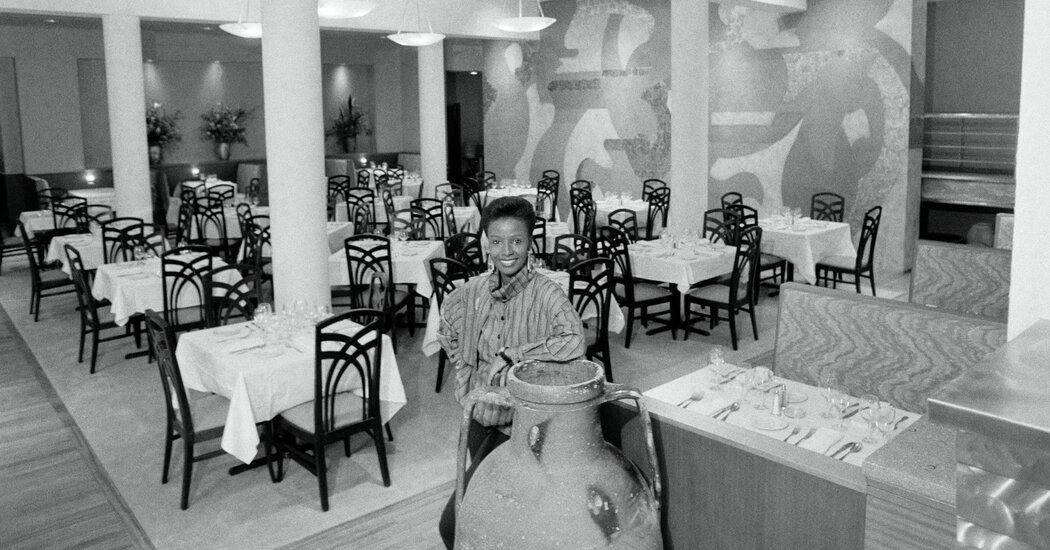
4 Black Women Who Mixed Fine Dining, Fashion and Art in New York
- Business
- February 25, 2025
- No Comment
- 136
These four restaurants were synonymous with their owners, all serving their takes on soul or Southern food. Before they arrived, a craving for soul food meant heading uptown to Harlem for takeout containers or sitting down at Sylvia’s, opened by Sylvia Woods in 1962 near the famed Apollo Theater.
These newer places continued the story, bringing worldly, upscale takes on Southern food downtown. Each space was a view into a world curated and inspired by its creator. And each, in its time, offered some of the most coveted seats in the city; their legacy can still be seen in the number of restaurants today highlighting Black stories. Budding entrepreneurs like Melba Wilson and Marcus Samuelsson were inspired to build their own restaurant empires by seeing these pioneers build theirs.
Below, friends of these trailblazing women and guests of their restaurants share memories of what the chefs and their restaurants meant to them.
Alberta Wright
The Worldly Doyenne of Black Fine Dining
Jezebel 1983-2007
Few restaurants elicit such nostalgic sighs as Jezebel, a busy and ornate Southern restaurant in the theater district that Alberta Wright opened in 1983.
“Jezebel’s wasn’t just a restaurant, it was a happening,” said Bevy Smith, the actress and television and radio host. “I remember being 22 and being in awe.” The dining room, “a riot of colors and patterns,” elicited the same reaction, she said. Large, framed art hung on the fuchsia and red walls; fabrics dangled from the ceiling, interspersed with chains that held up (extremely coveted) swing seats. “It was so joyful,” Ms. Smith said. “It would have been the most Instagrammable soul food restaurant in the world if it was open today.”
Long before her restaurant opened, Ms. Wright showed an eye for detail and fashion, said the model and activist Bethann Hardison. “I knew Alberta because her secondhand store was quite popular,” she said. “But she always wanted to have a restaurant.” Ms. Wright, wanting full ownership of her business, took out a mortgage for a space on Ninth Avenue on the corner of 45th Street in 1983. “She wanted to tell her story, and she wanted to do it right then,” Ms. Hardison added.
Ms. Wright, a native of Pineville, S.C., served upscale soul food classics with Lowcountry inflections, like she-crab soup laced with sherry wine, broiled red snapper with cornbread and oyster stuffing, and shrimp Creole with rice and okra. “It really was exceptional Southern cooking,” said Ms. Hardison.
But beyond the meals, dining at Jezebel meant being nurtured by Ms. Wright, who died in 2015. “She really infused the place with her essence,” Ms. Smith said. “It was life-affirming to be able to eat in a space that nice owned by a Black woman. It told me, ‘I can still be fancy and I don’t have to code-switch.’”
Toukie’s 1994-1998
Toukie’s isn’t remembered for its menu of approachable dishes like peach cobbler, pasta and chicken wings, or even for its interior with bright red banquettes and a mural of famous women including Elizabeth Taylor and the restaurant’s owner, Toukie Smith. Toukie’s is emblazoned in people’s memories because of a sound: Ms. Smith’s booming voice, which carried through the establishment’s dimly lit space on West Houston Street.
Ms. Smith, who is now 72, wore many hats in the 1980s and ’90s: An actress who appeared on television shows like “227” and in movies, she was frequently included in fashion spreads in popular women’s magazines like Elle and Cosmopolitan. Her likeness was also used as the inspiration for the renowned mannequin line, created in the ’70s by Adel Rootstein.
But a restaurant of her own beckoned. Maybe it was because she wanted to continue to work in food after her catering company, Toukie’s Taste, ended operations in 1992, or because she wanted another stage.
“It was the joy of hosting that drove her,” said Ms. Hardison. As a friend of the designer Willi Smith, Toukie’s older brother, who died in 1987, Ms. Hardison watched as Ms. Smith, moved to New York City from Philadelphia to attend fashion school, not only expanding her reach in the fashion world but also creating her own community.
At Toukie’s her community could see, dine (on dishes like Black bottom pie) and drink with its host in SoHo (she would frequently join tables and eat with them). Arriving guests were given a kiss, which branded them with Ms. Smith’s signature red lipstick. Sometimes they even spotted models Grace Jones or Barbara Summers or said hello to Ms. Smith’s partner at the time, and investor in the restaurant, Robert De Niro, with whom Ms. Smith had twins in 1995.
Little Kitchen 1965-1989
Princess Pamela’s Southern Touch 1989-1998
Called “the high priestess of soul food” in a 1968 article in The New York Daily News, Pamela Strobel ruled the land of Little Kitchen, the 16-seat restaurant on the ground level of her home in the East Village. Little Kitchen was part private restaurant and part jazz club, where Ms. Strobel served simple dishes like fried chicken, smothered pork chops with collard greens, and black-eyed peas and Sauce Beautiful (named after her mother, who went by Beauty), a warm, piquant mixture of peach preserves thinned with lemon juice, vinegar and butter.
Ms. Strobel, who hailed from Spartanburg, S.C., was tight-lipped about her upbringing, and quick to turn guests away if she didn’t like their questions (sometimes after they had already entered) or if her mood soured. “She could actually be quite fun when she wasn’t pouting or cussing you out,” recalled Alexander Smalls, the author and restaurateur. “She was sassy and she demanded respect.” To the present day, the press and online sleuths have been unable to determine if she’s still alive, having dropped out of public sight after her restaurant closed in 1998. (Matt and Ted Lee, the brothers who helped publish the 2017 edition of her cookbook, hired a private investigator to look into her final resting place or whereabouts after she closed her restaurant in 1998, but the “trail went cold,” they said.)
Sheila Christine McLaughlin, who directed the 1987 film “She Must Be Seeing Things,” in which Ms. Strobel made her only filmed appearance, remembers the restaurant as a mysterious place. “I went once, and it was kind of a different world,” she said. “I wanted the Black character in the film to have a world without white people, and Little Kitchen felt like a place that centered Black cooking.” She asked if she could film in the space for her movie, and to her surprise, the notoriously fussy Ms. Strobel said yes. Perhaps, she added, that was because she saw in Ms. McLaughlin a kindred spirit — another creative person who was working hard to make something her own in New York City.
“She was clearly in control of her story and she wasn’t letting anyone mess with it,” Ms. McLaughlin said. The result was a scene in which Ms. Strobel, draped in a shimmering gold frock, serenaded guests in the dining room, looking every bit the part of a lounge singer owning her domain. Her song, a bluesy number in which she croons that “everyone’s worried” since she came to town, was all off the cuff. “She freestyled a song and a refrain, and it was kind of extraordinary she could do that,” Ms. McLaughlin said. “It was magical.”
If you were welcomed as a guest, it was an invitation to worship at the altar of the long line of women who had taught Ms. Strobel. Memories of those women permeate her only cookbook, “Princess Pamela’s Soul Food Cookbook,” originally published in 1969.
“One thing I knew was how to cook cause Beauty was a head pastry chef,” she writes in the book, in a poem to honor her mother. “And now with them famous folks comin’ round to my place — I feel like they is kissin’ Beauty’s hands.”
B. Smith
The Aspirational Mogul
B. Smith’s (Multiple locations) 1986-2015
A red awning with cursive writing reading “B. Smith’s” announced that you had arrived at the restaurant of the model, entrepreneur and author B. Smith. Originally opened in 1986, “B. Smith’s restaurant was a great gift to Black people,” said Susan L. Taylor, a former editor in chief of the magazine Essence and the founder and chief executive of the National CARES Mentoring Movement. “Jezebel and B. Smith’s were sanctuaries where Black people were made to feel at home, and the guests were a diverse mix of locals, out-of-town visitors, celebrities and dignitaries.”
Despite Ms. Smith’s natural abilities as a restaurateur, the food world was not originally part of her plans. Ms. Hardison remembers meeting her when Ms. Smith was a young model who “all of sudden was into restaurants and wanted her own.”
She added: “It was lovely to see her embrace a dream that she just happened upon.”
Ms. Smith, who grew up outside Pittsburgh, would eventually open two more locations, in Sag Harbor, N.Y., and Union Market in Washington, D.C.; her empire grew to include a magazine and numerous television shows.
“Barbara was the ultimate host, greeting guests with her radiant smile, walking through the restaurant looking fabulous, stopping to chat at tables,” Ms. Taylor said.
“The food was divine,” she remembered. Her favorite menu items included crab croquettes served with a Lowcountry potato salad and a rémoulade dipping sauce, and a kale salad topped with shrimp or salmon. “And the bourbon bread pudding was sinful!”
The elegance and the refinement of the space, built with an overhanging deck for live jazz music and decorated in calming sepia and mahogany tones, offered a retreat for after-work meetings and dinners. Stars who lived and performed in the area would often stop by: Melba Moore, Jennifer Holliday, Billy Porter, Sheryl Lee Ralph. “In retrospect, it had the feel of a Harlem Renaissance in Hell’s Kitchen,” Ms. Taylor said.
Always composed, Ms. Smith, who died in 2020, was no stranger to critics who thought her brand of casual, breezy elegance wasn’t authentic to a Black story. She told The Los Angeles Times in 2000 that it was hard, but that she had learned to have “tougher skin.” Having a space to retreat to, to own, to fully embrace offered a respite. “That’s why you have to surround yourself with your friends and family, and you have to have your own world.”
#Black #Women #Mixed #Fine #Dining #Fashion #Art #York









